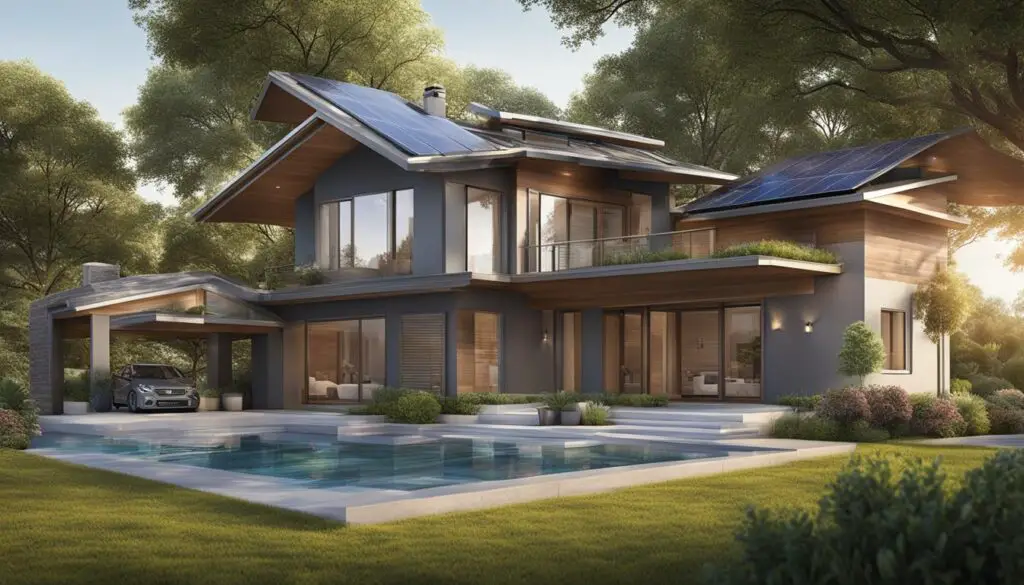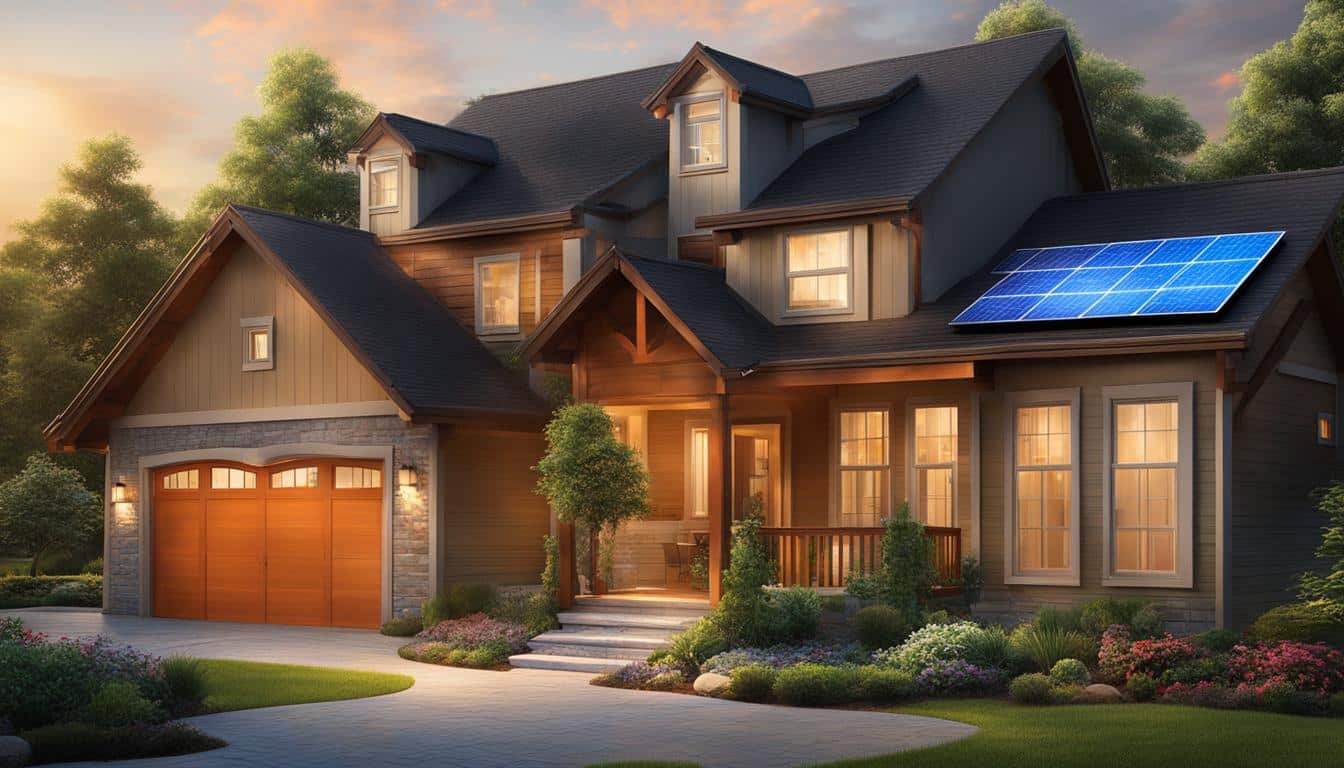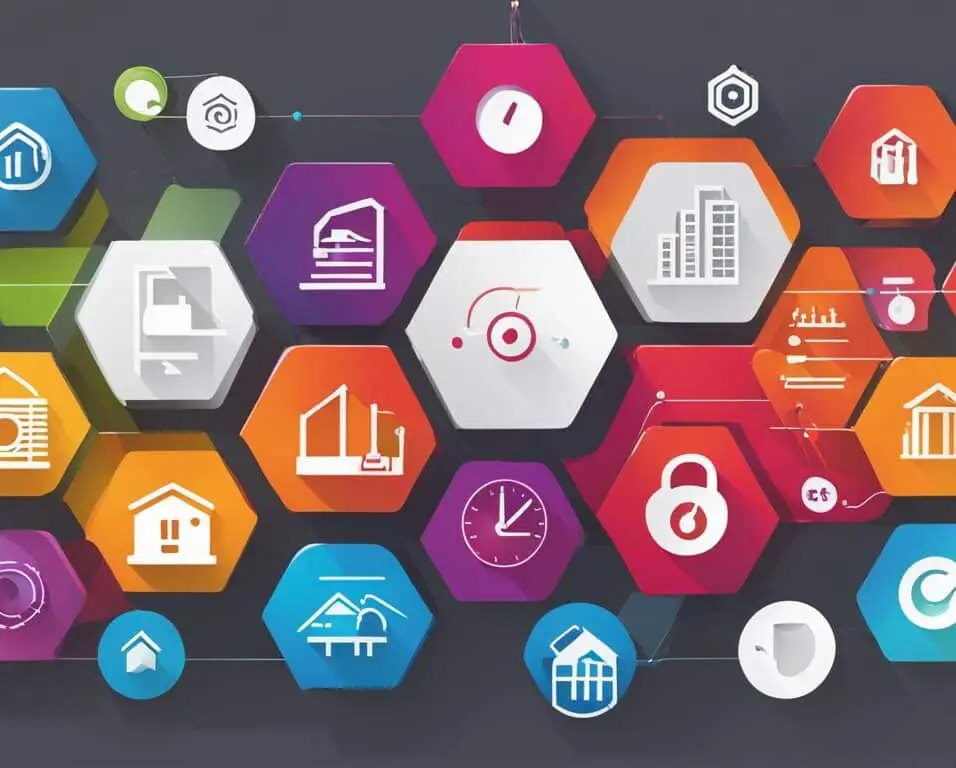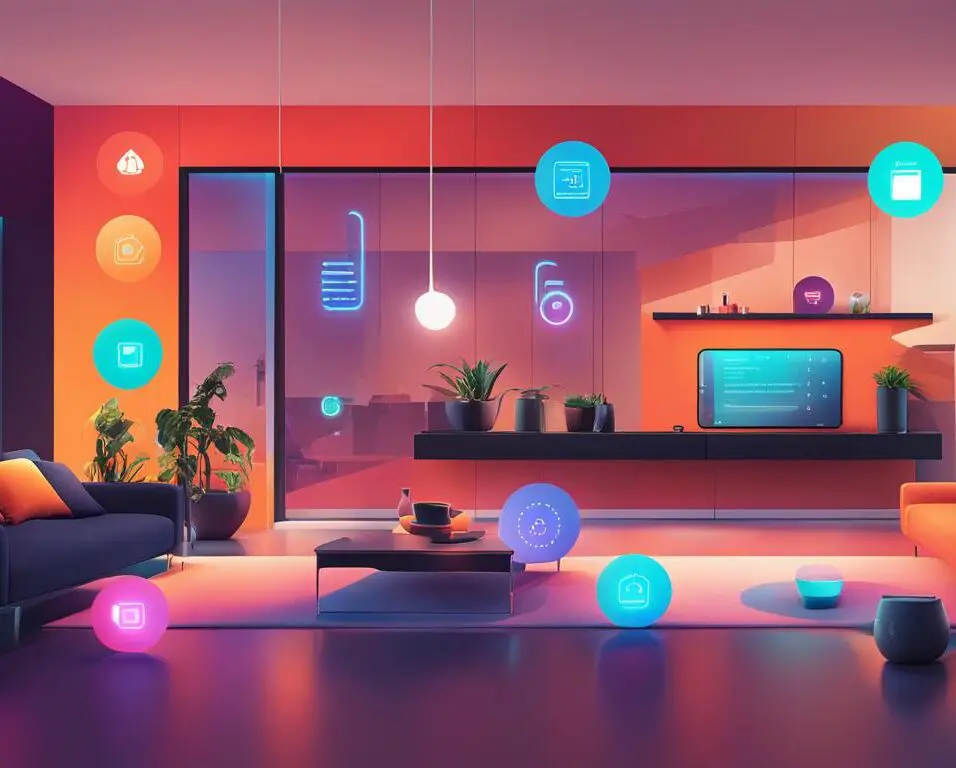IoT and Home Efficiency: A Perfect Match
What is Ambient Energy, and How Does It Work?
Ambient energy is a valuable resource that surrounds us in our everyday environment. It refers to the energy present in various forms such as solar radiation, temperature differences, wind, human movement, and RF waves. This energy is constantly available, waiting to be captured and harnessed for our benefit.
Energy harvesting devices play a crucial role in converting ambient energy into usable electricity. These devices are designed to capture and convert the energy present in our surroundings into a form that can power various applications. From tiny sensors to entire buildings, the potential applications of ambient energy are vast.
By harnessing ambient energy, we can reduce our reliance on traditional batteries and tap into a renewable energy source. This has significant implications for sustainability and combating climate change. Rather than depleting Earth’s resources, we can utilize the energy that is freely available in our environment.
Energy harvesting devices capture and convert ambient energy into electricity, reducing reliance on traditional batteries and helping preserve Earth’s resources.
Imagine a world where our everyday devices can be powered by the energy around us. This vision is becoming a reality with the advancements in ambient energy harvesting. From powering wireless sensors in smart homes to providing energy for remote monitoring systems, ambient energy holds immense potential.
| Advantages of Ambient Energy | Applications |
|---|---|
|
|
Ambient energy holds immense potential in shaping a more sustainable future. By harnessing the power of renewable energy sources that surround us, we can reduce our environmental impact and create a cleaner, greener world.
Unveiling the Internet of Things (IoT)
The Internet of Things (IoT) is a transformative network that connects a wide range of smart devices, sensors, and systems, enabling them to communicate and exchange data over the internet. These IoT devices play a pivotal role in shaping our homes, cities, and workplaces, revolutionizing the way we interact with technology and our surroundings.
Smart devices, such as thermostats, security cameras, and voice assistants, are key components of the IoT ecosystem. Equipped with sensors and connectivity capabilities, these devices collect vast amounts of data from their environments. This data is then transmitted to other devices or centralized systems for analysis.
Automation is an integral part of the IoT’s functionality. By leveraging real-time data insights, IoT devices can automate processes and make informed decisions. For example, a smart home system can automatically adjust the temperature based on occupancy, reducing energy consumption while maintaining comfort.
The growth of the IoT has been monumental, with billions of devices being connected worldwide. It has the potential to transform various industries, including healthcare, transportation, agriculture, and manufacturing. The possibilities are limitless, as the IoT continues to evolve and expand its reach.
The Internet of Things (IoT) connects a wide range of smart devices, sensors, and systems, enabling them to communicate and exchange data over the internet.
However, the increasing energy demand of IoT devices poses a challenge. To ensure a sustainable and efficient IoT ecosystem, there is a need for a renewable energy source that can power these devices without depleting finite resources. This is where ambient energy, harnessed by energy harvesting devices, comes into play.
Ambient energy refers to the energy present in the environment, such as solar radiation, temperature differences, and motion. Energy harvesting devices capture and convert this ambient energy into usable electricity, providing a sustainable power source for IoT devices. By leveraging ambient energy, we can reduce reliance on traditional batteries and minimize the environmental impact of the IoT.
In the next section, we will explore how ambient energy can be seamlessly integrated with the IoT and ONiO.zero microcontrollers, creating a self-sustaining ecosystem of intelligent devices.
The Dream Team: Merging Ambient Energy with IoT and ONiO.zero
By merging ambient energy with IoT and ONiO.zero, a batteryless microcontroller optimized for ambient energy, we can create a self-sustaining ecosystem of intelligent devices. This combination allows IoT devices to draw energy from their surroundings, reducing reliance on traditional sources and making the system more eco-friendly and efficient.
The synergy between ambient energy, IoT, and ONiO.zero enables seamless integration and sustainable innovation. ONiO.zero, with its energy-efficient design, ensures that IoT devices can operate without the need for battery replacements. This not only minimizes waste but also simplifies maintenance and contributes to overall energy efficiency.
“The potential of merging ambient energy, IoT, and ONiO.zero is truly groundbreaking,” says Dr. Sarah Thompson, a leading expert in sustainable technology. “It opens up a world of possibilities for creating smart and energy-efficient solutions across various industries.”
The IoT plays a crucial role in this collaboration, acting as the communication hub that collects real-time data from these energy-efficient devices. This data empowers us to make informed decisions about energy usage and identify areas for optimization. With the ability to monitor and control energy consumption at a granular level, we can maximize energy efficiency and reduce unnecessary waste.
Moreover, the integration of ambient energy, IoT, and ONiO.zero paves the way for sustainable innovation. It allows for the development of energy-efficient applications that can revolutionize industries such as asset tracking, structural health monitoring, and electronic shelf labels.
Harnessing the power of ambient energy with IoT and ONiO.zero offers a compelling solution to the global challenges of energy consumption and sustainability. It not only reduces our carbon footprint but also unlocks new possibilities for creating smarter, greener, and more efficient systems.
Real-world Applications: Unleashing the Potential of Wireless Batteryless Microcontrollers
Wireless batteryless microcontrollers powered by ambient energy have paved the way for innovative and energy-efficient applications across various industries. These cutting-edge devices are revolutionizing asset tracking, structural health monitoring, and electronic shelf labels.
Ultra-Wideband Asset Tracking
The integration of wireless batteryless microcontrollers in asset tracking systems enables real-time and accurate tracking throughout the supply chain. With ultra-wideband technology, these microcontrollers can precisely locate and monitor assets, ensuring efficient logistics and reducing the risk of loss or theft. By harnessing ambient energy, these devices eliminate the need for batteries, making asset tracking more sustainable and cost-effective.
Structural Health Monitoring
Wireless batteryless microcontrollers are also instrumental in enhancing structural health monitoring in buildings and bridges. By embedding these microcontrollers in critical structural components, engineers can continuously monitor the health and integrity of the structures. Real-time data collected by the microcontrollers can detect potential issues, such as cracks or vibrations, before they escalate into catastrophic failures. The use of ambient energy as a power source eliminates the need for frequent battery replacements and ensures uninterrupted monitoring.
Batteryless Electronic Shelf Labels
Retail environments can benefit from the energy-efficient applications of wireless batteryless microcontrollers through the implementation of electronic shelf labels (ESLs). These batteryless microcontrollers can power ESLs, which display product information, prices, and promotions on store shelves. With ambient energy harvesting capabilities, ESLs can update in real-time, eliminating the manual process of changing paper labels. This technology streamlines operations for retailers and enhances the shopping experience for customers.
By leveraging the capabilities of wireless batteryless microcontrollers, industries can improve efficiency, increase sustainability, and optimize their processes. From asset tracking to structural health monitoring and electronic shelf labels, these energy-efficient applications unlock new possibilities for businesses and consumers alike.

IoT and SDG 7: Affordable and Clean Energy
The Internet of Things (IoT) is instrumental in achieving Sustainable Development Goal 7 – Affordable and Clean Energy. By connecting devices and systems to the internet, we can optimize energy efficiency in buildings and reduce overall energy consumption. With IoT technology, smart thermostats, for instance, can adjust temperature settings based on occupancy and weather conditions, resulting in energy savings and improved comfort.
“The energy-saving potential of IoT technology is immense,” states John Davis, an energy efficiency expert. “By seamlessly integrating devices and enabling real-time monitoring and control, we can make significant strides towards achieving a more affordable and clean energy future.”
A key advantage of IoT technology lies in its ability to collect and analyze data from various systems, enabling informed decision-making to improve energy efficiency. With advanced analytics and machine learning algorithms, energy usage patterns can be identified, optimizing energy distribution and minimizing wastage. This data-driven approach empowers individuals and organizations alike to make more sustainable choices.
Furthermore, the implementation of IoT-enabled smart grids allows for better management and distribution of electricity, reducing the strain on the grid and promoting a more reliable and resilient energy infrastructure. Smart meters, integrated with IoT technology, provide real-time data on energy consumption, enabling consumers to monitor and adjust their usage habits accordingly.

As the world strives to achieve Sustainable Development Goal 7, the integration of IoT technology into energy systems plays a pivotal role in realizing a more sustainable and environmentally friendly future. By leveraging the power of IoT, we can optimize energy efficiency, reduce greenhouse gas emissions, and work towards meeting our global energy needs in a cleaner, more affordable manner.
Conclusion
Integrating IoT devices into our homes and leveraging ambient energy can revolutionize our living spaces, enhancing efficiency and creating smarter environments. By harnessing the synergy between ambient energy and IoT technology, we can tap into renewable energy sources and make informed decisions about energy usage. This integration opens up new possibilities for sustainable and efficient smart home solutions.
With IoT devices seamlessly connected and communicating over the internet, our homes become intelligent ecosystems that optimize energy consumption, enhance convenience, and contribute to a greener future. By embracing these technological advancements, we can reduce reliance on traditional energy sources and minimize our carbon footprint, creating a more eco-friendly and sustainable living environment.
By integrating IoT devices and leveraging ambient energy, we unlock the potential for energy-efficient solutions in various aspects of our lives. From ultra-wideband asset tracking in supply chains to structural health monitoring in buildings, and even batteryless electronic shelf labels in retail, the combination of IoT and ambient energy offers endless possibilities for energy-efficient applications.
As we continue to embrace the integration and expansion of IoT devices in our homes, we move closer to achieving a greener, more efficient future. By leveraging ambient energy and making conscientious decisions about energy usage, we can create smarter living spaces that contribute to a sustainable and environmentally friendly world for generations to come.
FAQ
How can IoT devices enhance home efficiency?
By integrating IoT devices into our homes, we can create smarter living spaces that are more convenient, efficient, and eco-friendly. IoT devices collect and share data, automate processes, and make decisions based on real-time information, optimizing energy efficiency and reducing overall energy consumption.
What is ambient energy and how does it work?
Ambient energy refers to the energy present in the environment, such as solar radiation, temperature differences, wind, human movement, and RF waves. Energy harvesting devices can capture and convert ambient energy into electricity, which can then be used to power various applications, from tiny sensors to entire buildings. Harnessing ambient energy helps reduce reliance on traditional batteries and preserves Earth’s resources.
What is the Internet of Things (IoT) and how does it revolutionize homes?
The IoT is a vast network of smart devices, sensors, and systems that communicate with each other over the internet. By connecting devices and systems to the internet, the IoT enables real-time data collection, automation, and decision-making. This revolutionizes homes by optimizing energy efficiency, enabling smart thermostats, real-time monitoring of energy usage, and control of various systems. It contributes to a more affordable and clean energy future.
How does merging ambient energy with IoT and ONiO.zero optimize energy efficiency?
By merging ambient energy with IoT and ONiO.zero, a batteryless microcontroller optimized for ambient energy, we can create a self-sustaining ecosystem of intelligent devices. This allows IoT devices to draw energy from their surroundings, reducing reliance on traditional sources and making the system more eco-friendly and efficient. The IoT can collect real-time data from these devices, empowering us to make informed decisions about energy usage and improve overall efficiency.
What are some real-world applications of wireless batteryless microcontrollers powered by ambient energy?
Wireless batteryless microcontrollers powered by ambient energy have a wide range of applications. They can enable ultra-wideband asset tracking, ensuring real-time and accurate tracking throughout the supply chain. They can be used for structural health monitoring in buildings and bridges, detecting potential structural issues before they become catastrophic. Additionally, they can power batteryless electronic shelf labels in retail environments, providing efficiency and convenience for both retailers and consumers.
How does IoT contribute to Sustainable Development Goal 7 – Affordable and Clean Energy?
The IoT plays a crucial role in achieving Sustainable Development Goal 7 – Affordable and Clean Energy. By connecting devices and systems to the internet, we can optimize energy efficiency in buildings and reduce overall energy consumption. Smart thermostats, for example, can adjust temperature settings based on occupancy and weather conditions, saving energy and improving comfort. IoT technology allows for real-time monitoring and control of various systems, contributing to a more affordable and clean energy future.
How can integrating IoT devices and leveraging ambient energy enhance home efficiency?
By integrating IoT devices into our homes and leveraging ambient energy, we can significantly enhance efficiency and create smarter living spaces. The synergy between ambient energy and IoT allows us to harness renewable energy sources and make informed decisions about energy usage. By embracing these technological advancements, we can create a greener, more efficient future for ourselves and the planet.








